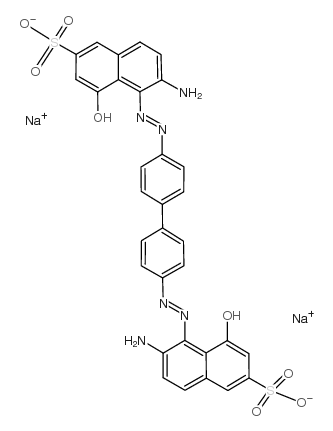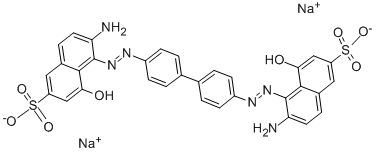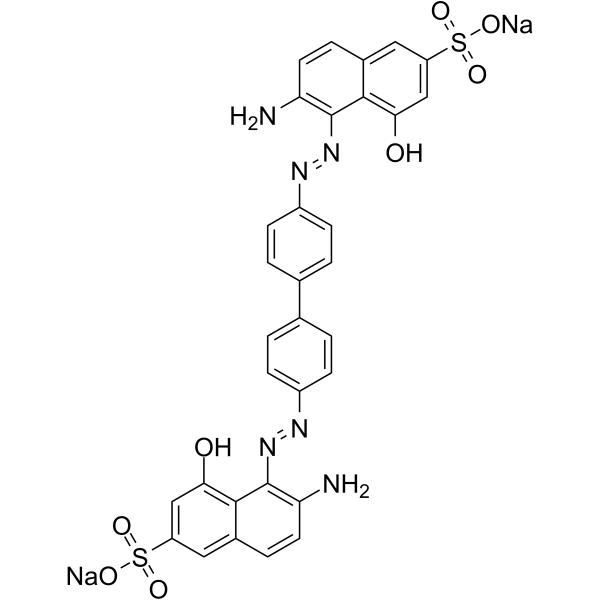直接紫1, 生物染料,Direct violet1
产品编号:西域试剂-WR174469| CAS NO:2586-60-9| 分子式:C32H22N6Na2O8S2| 分子量:728.66
Direct Violet 1 是一种偶氮染料,是一种纺织品染料。Direct Violet 1 还是一种 SARS-CoV-2 spike 蛋白与 ACE2 的蛋白-蛋白相互作用 (PPI) 的抑制剂,IC50 为 1.47-2.63 µM。
本网站销售的所有产品仅用于工业应用或者科学研究等非医疗目的,不可用于人类或动物的临床诊断或者治疗,非药用,非食用,
| 英文名称 | Direct violet1 | ||||||||||||||||
|---|---|---|---|---|---|---|---|---|---|---|---|---|---|---|---|---|---|
| CAS编号 | 2586-60-9 | ||||||||||||||||
| 产品描述 | Direct Violet 1 是一种偶氮染料,是一种纺织品染料。Direct Violet 1 还是一种 SARS-CoV-2 spike 蛋白与 ACE2 的蛋白-蛋白相互作用 (PPI) 的抑制剂,IC50 为 1.47-2.63 µM。 | ||||||||||||||||
| 产品密度 | 1.64g/cm3 | ||||||||||||||||
| 精确质量 | 728.07400 | ||||||||||||||||
| PSA | 273.10000 | ||||||||||||||||
| LogP | 10.19860 | ||||||||||||||||
| 外观性状 | 固体;Red to Dark blue to Black powder to crystal | ||||||||||||||||
| 折射率 | 1.771 | ||||||||||||||||
| 溶解性数据 | In Vitro:
H2O : 62.5 mg/mL (85.77 mM; Need ultrasonic) 配制储备液
*
请根据产品在不同溶剂中的溶解度选择合适的溶剂配制储备液;一旦配成溶液,请分装保存,避免反复冻融造成的产品失效。 | ||||||||||||||||
| 靶点 |
IC50: 1.47 µM (SARS-CoV-2-S-RBD binding to ACE2); 2.63 µM (SARS-CoV-S1S2 binding to ACE2); 2.11 µM (TNF-R1-TNFα binding) | ||||||||||||||||
| 体外研究 | 直接紫1抑制SARS-CoV-2-S-RBD与人ACE2结合,抑制SARS-CoV-S1S2与ACE2结合,抑制TNF-R1与TNF结合α IC50值为1.47µM、 2.63美元µM、 和2.11µM、 分别为。直接紫1抑制SARS-CoV-2假病毒进入hACE2表达的宿主细胞呈浓度依赖性,IC50为35.8µM。 | ||||||||||||||||
| 稳定性 | 遇浓硫酸呈深蓝色,稀释后呈暗紫色。遇浓硝酸呈红棕色。对于纤维素纤维染色,染料吸尽性好,温度在100℃亲和力最大 | ||||||||||||||||
| 储存条件 | 密封于阴凉干燥环境。 |
相关文档
化学品安全说明书(MSDS)
下载MSDS质检证书(COA)
相关产品
| RTECS号 | QK1420000 |
|---|
|
Chlorazol Violet N
Revision number: 1
SAFETY DATA SHEET Section1. BASE INFORMATION Product name:Chlorazol Violet N Revision number:1 Section2. HAZARDS IDENTIFICATION Classification of the GHS PHYSICAL HAZARDSNot classified HEALTH HAZARDSNot classified Not classified ENVIRONMENTAL HAZARDS GHS label elements None Pictograms or hazard symbols Signal wordNo signal word None Hazard statement Precautionary statementsNone Section3. COMPOSITION/INFORMATION ON INGREDIENTS Substance/mixture:Substance Component(s):Chlorazol Violet N Percent:.... CAS Number:2586-60-9 Synonyms:Diamine Violet N , Dianil Violet H , Direct Violet 1 , Erie Violet 3R , Pontamine Violet N Chemical Formula:C32H22N6Na2O8S2 Section4. FIRST AID MEASURES Inhalation:Remove victim to fresh air and keep at rest in a position comfortable for breathing. Get medical advice/attention if you feel unwell. Skin contact:Remove/Take off immediately all contaminated clothing. Rinse skin with water/shower. If skin irritation or rash occurs: Get medical advice/attention. Eye contact:Rinse cautiously with water for several minutes. Remove contact lenses, if present and easy to do. Continue rinsing. If eye irritation persists: Get medical advice/attention. Ingestion:Get medical advice/attention if you feel unwell. Rinse mouth. Protection of first-aiders:A rescuer should wear personal protective equipment, such as rubber gloves and air- tight goggles. Section5. FIRE-FIGHTING MEASURES Suitable extinguishingDry chemical, foam, water spray, carbon dioxide. media: Specific hazards:Take care as it may decompose upon combustion or in high temperatures to generate poisonous fume. Chlorazol Violet N Section5. FIRE-FIGHTING MEASURES Specific methods:Fire-extinguishing work is done from the windward and the suitable fire-extinguishing method according to the surrounding situation is used. Uninvolved persons should evacuate to a safe place. In case of fire in the surroundings: Remove movable containers if safe to do so. Special protectiveWhen extinguishing fire, be sure to wear personal protective equipment. equipment for firefighters: Section6. ACCIDENTAL RELEASE MEASURES Use personal protective equipment. Keep people away from and upwind of spill/leak. Personal precautions, protective equipment and Entry to non-involved personnel should be controlled around the leakage area by emergency procedures: roping off, etc. Environmental precautions: Prevent product from entering drains. Methods and materials for Sweep dust to collect it into an airtight container, taking care not to disperse it. containment and cleaning Adhered or collected material should be promptly disposed of, in accordance with up: appropriate laws and regulations. Section7. HANDLING AND STORAGE Handling Handling is performed in a well ventilated place. Wear suitable protective equipment. Technical measures: Prevent dispersion of dust. Wash hands and face thoroughly after handling. Use a local exhaust if dust or aerosol will be generated. Advice on safe handling:Avoid contact with skin, eyes and clothing. Storage Storage conditions:Keep container tightly closed. Store in a cool and dark place. Store away from incompatible materials such as oxidizing agents. Packaging material:Law is followed. Section8. EXPOSURE CONTROLS / PERSONAL PROTECTION Engineering controls:Install a closed system or local exhaust as possible so that workers should not be exposed directly. Also install safety shower and eye bath. Personal protective equipment Respiratory protection: Dust respirator. Follow local and national regulations. Hand protection:Protective gloves. Eye protection:Safety glasses. A face-shield, if the situation requires. Skin and body protection: Protective clothing. Protective boots, if the situation requires. Section9. PHYSICAL AND CHEMICAL PROPERTIES Physical state (20°C):Solid Form:crystal - powder Color:Deep yellow red - Black Odor:No data available pH: No data available Melting point/freezing point:No data available Boiling Point/Range:No data available Flash Point:No data available Explosive limits Lower:No data available Upper:No data available Density:No data available Solubility:No data available Section10. STABILITY AND REACTIVITY Stability:Stable under proper conditions. Reactivity:No special reactivity has been reported. Incompartible materials: oxidizing agents Chlorazol Violet N Section10. STABILITY AND REACTIVITY Hazardous Decomposition Carbon monoxide, Carbon dioxide, Nitrogen oxides (NOx), Sulphur oxides Products: Section11. TOXICOLOGICAL INFORMATION Acute Toxicity:No data available Skin corrosion/irritation: No data available Serious eyeNo data available damage/irritation: Germ cell mutagenicity: No data available Carcinogenicity: IARC =No data available NTP =No data available Reproductive toxicity:No data available RTECS Number:QK1420000 Section12. ECOLOGICAL INFORMATION Ecotoxicity: Fish:No data available No data available Crustacea: Algae:No data available Persistence / degradability: No data available BioaccumulativeNo data available potential(BCF): Mobillity in soil No data available log Pow: Soil adsorption (Koc):No data available No data available Henry's Law constant(PaM3/mol): Section13. DISPOSAL CONSIDERATIONS Recycle to process, if possible. Consult your local regional authorities. You may be able to dissolve or mix material with a combustible solvent and burn in a chemical incinerator equipped with an afterburner and scrubber system. Observe all federal, state and local regulations when disposing of the substance. Section14. TRANSPORT INFORMATION Does not correspond to the classification standard of the United Nations Hazards Class: UN-No:Not Listed Section15. REGULATORY INFORMATION Safe management ordinance of dangerous chemical product (State Council announces on January 26, 2002): Safe use and production, the storage of a dangerous chemical, transport, loading and unloading were prescribed. Chlorazol Violet N SECTION 16 - ADDITIONAL INFORMATION N/A |









 浙公网安备 33010802013016号
浙公网安备 33010802013016号